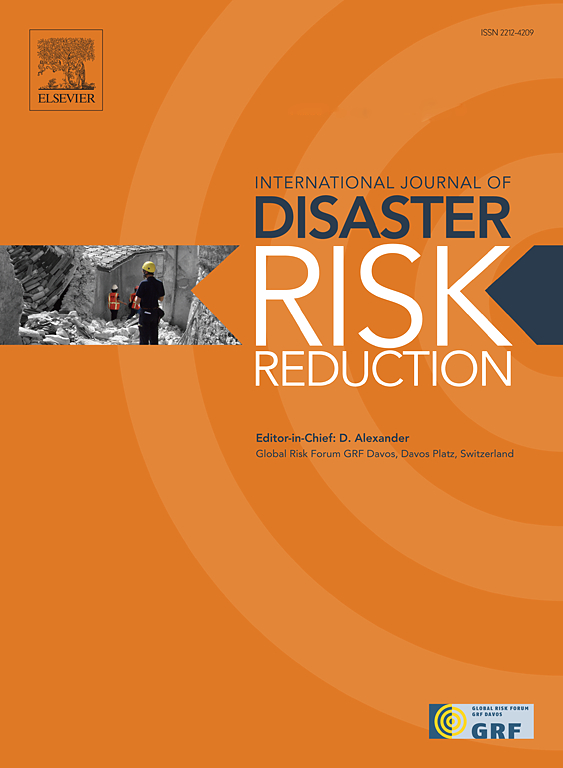气候变化影响和相关不确定性的图形表示,以便在水文灾害管理中更好地制定政策
IF 4.2
1区 地球科学
Q1 GEOSCIENCES, MULTIDISCIPLINARY
International journal of disaster risk reduction
Pub Date : 2025-04-01
DOI:10.1016/j.ijdrr.2025.105449
引用次数: 0
摘要
气候变化的影响在区域尺度上是不同的,因此需要对区域进行具体分析。对气候变化及其影响的预测充满了不确定性,在进行更精细的分析时,这种不确定性会加剧。区域尺度的气候变化影响预测在用于政策制定或设计程序时,应考虑预测结果的不确定性。忽视不确定性可能导致糟糕的政策决策和不完善的结构。将不确定性纳入政策行动的一个主要限制是科学界如何将不确定性传达给决策者和利益攸关方。研究发现,简单的图解方法能有效地向公众传达研究成果。本研究提出了一种报告区域尺度气候变化影响及其相关不确定性的图解方法。风险概念结合了事件强度、频率和区域脆弱性等信息,用于传达极端事件对集水区的影响。风险被定义为一个指数,以方便在不同时期和多个场景之间比较不同级别的事件。不确定性表示为每个事件预测的风险范围,并在集合预测的基础上建立一个置信度水平。将多个极端事件的预测风险与该地区发生的历史事件的计算风险进行比较,从而使政策制定者能够将指数与实际后果联系起来。本文章由计算机程序翻译,如有差异,请以英文原文为准。
Graphical representation of climate change impacts and associated uncertainty to enable better policy making in hydrological disaster management
The effects of climate change are felt differently on regional scales, necessitating region specific analysis. Prediction of climate change and its impacts is riddled with uncertainties, which is exacerbated when moving to finer scale analysis. Climate change impact predictions on regional scales, when used for policy making or in design procedure should consider the uncertainty in the projected result. Ignoring the uncertainty can lead to poor policy decisions and inadequate structures. A major limitation in combining uncertainties in policy action is in how the uncertainty is communicated by the scientific community to policy makers and stakeholders. Simple graphical approaches have been found to be effective in communicating research outcomes to the public. The present study proposes a graphical approach for reporting regional scale climate change impacts and their associated uncertainty from an ensemble projection of regional extreme events. The concept of risk, which combines the information of event magnitude, frequency and regional vulnerabilities, is used to convey the impacts of extreme events over a catchment. The risk is defined as an index to facilitate comparison between different magnitude events, across different time periods, and across multiple scenarios. The uncertainty is represented as the range of risk predicted for each event and a level of confidence is developed based on the ensemble prediction. The projected risks of multiple extreme events are plotted in comparison with calculated risk of historical events that occurred in the region, to enable a policy maker to relate the index with actual consequences.
求助全文
通过发布文献求助,成功后即可免费获取论文全文。
去求助
来源期刊

International journal of disaster risk reduction
GEOSCIENCES, MULTIDISCIPLINARYMETEOROLOGY-METEOROLOGY & ATMOSPHERIC SCIENCES
CiteScore
8.70
自引率
18.00%
发文量
688
审稿时长
79 days
期刊介绍:
The International Journal of Disaster Risk Reduction (IJDRR) is the journal for researchers, policymakers and practitioners across diverse disciplines: earth sciences and their implications; environmental sciences; engineering; urban studies; geography; and the social sciences. IJDRR publishes fundamental and applied research, critical reviews, policy papers and case studies with a particular focus on multi-disciplinary research that aims to reduce the impact of natural, technological, social and intentional disasters. IJDRR stimulates exchange of ideas and knowledge transfer on disaster research, mitigation, adaptation, prevention and risk reduction at all geographical scales: local, national and international.
Key topics:-
-multifaceted disaster and cascading disasters
-the development of disaster risk reduction strategies and techniques
-discussion and development of effective warning and educational systems for risk management at all levels
-disasters associated with climate change
-vulnerability analysis and vulnerability trends
-emerging risks
-resilience against disasters.
The journal particularly encourages papers that approach risk from a multi-disciplinary perspective.
 求助内容:
求助内容: 应助结果提醒方式:
应助结果提醒方式:


